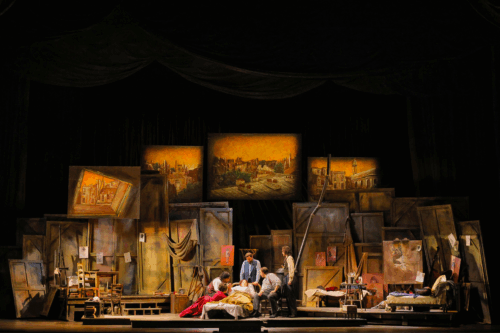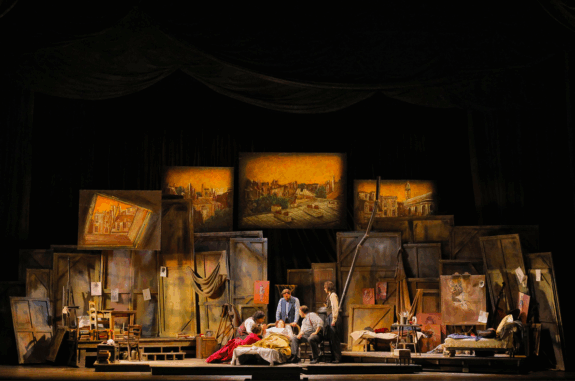 United States Puccini, La bohème: Soloists, Chorus and Orchestra of San Francisco Opera / Ramón Tebar (conductor). War Memorial Opera House, San Francisco, 3.6.2025. (HS)
United States Puccini, La bohème: Soloists, Chorus and Orchestra of San Francisco Opera / Ramón Tebar (conductor). War Memorial Opera House, San Francisco, 3.6.2025. (HS)

San Francisco Opera hasn’t mounted Puccini’s evergreen La bohème for almost a decade, which is a long time for an opera that seemed to come around every other year (45 times in the company’s 102 years). This revival of the 2017 Toulouse-Lautrec-infused co-production (with Houston Grand Opera and Canadian Opera Company) introduced some shining new faces and voices to local audiences.
In the first of nine performances (with two casts), the results may have been a bit mixed, but the essence of the opera came through vividly. Major credit goes to the detailed and apt work by revival director Katherine M. Carter (herself making her house debut) and supple, expressive conducting by Spanish maestro Ramón Tebar, who fashioned a memorable Elixir of Love here in 2023.
The John Caird production opens and closes behind a scrim that features Toulouse-Lautrec-style images of Parisians, and framed versions of the artist’s works create timely reminders in the background. The sets conjure late nineteenth-century Paris vividly: the young men’s garret with all the flair of a crash pad, a rowdy Latin Quarter and a down-market city-gate neighborhood for Act III. The garret splits into two parts to rotate into the crowd scene seamlessly, and from the city-gate scene back to the garret for the finale, nicely fitting Puccini’s original four acts into the modern-day, one-intermission format.
Directing touches add to the verisimilitude. The four artistic young men interact with realistic bumptiousness, and each has distinct characteristics. We can tell by how they carry themselves and their gestures which one is a writer, painter, musician or philosopher. Mimì is dressed plainly but her youth shows through. Musetta is a comic delight in a tight-fitting and ruffled pink gown.
Rodolfo takes notes as Mimì sings her introductory aria, and he quotes from his notebook in the Act IV duet when they sing each other’s tunes from the Act I love duet. In Act III, Marcello is painting a mural on the tavern’s exterior wall which adds a frisson to one of the jabs he gets later from a departing Musetta (‘house-painter!’).
Vocally, the standouts in the (mostly) young cast were Andrea Carroll’s saucy Musetta and Lucas Meacham’s intense Marcello. Carroll, making her house debut, was a whirlwind of coquettishness with a sleek lyric soprano that bounced through her music. She stole the spotlight from the moment she entered, a pink beam of light following her through the crowd. She was a character used to getting attention. Her showcase aria, ‘Quando m’en vo’, was everything it should be – flamboyant and musically primed, and aimed sideways at her former sweetheart, Marcello.
Meacham, for his part, responded with a perfect combination of irritation and lust. He has sung big roles here, including Figaro in Barber of Seville, Don Giovanni and Eugene Onegin, and his stage presence and vibrant baritone made it all feel natural without missing a note.
Debut soprano Karen Chia-ling Ho delivered Mimì’s melodies with a soft edge but enough intensity to make musical climaxes eye-opening. It was an impressive first go, even if the meaning of the lyrics didn’t always come through clearly. It took a while for the voice of tenor Pene Pati (a favorite with San Francisco audiences since his days as an Adler Fellow) to settle in, but when it did their duets were sweet. Especially touching was the final scene, in which their voices melded together entrancingly.
Romanian bass Bogdan Talos made his company debut as Colline (the philosopher), and second-year Adler Fellow Samuel Kidd had a smooth baritone as Schaunard (the musician). Veteran baritone Dale Travis brought comic timing and robust vocalizing to the roles of Benoît the landlord and Musetta’s sugar-daddy, Alcindoro.

The Act I meet-cute, in which Mimì and Rodolfo introduce themselves to each other shyly and end up going off arm-in-arm, unfolded at an unhurried pace so the details of their attraction could emerge deftly. Their eye-to-eye connection was intoxicating, and both singers were natural and believable. The crowd in Act II could have been managed better, but the interchange among the Bohemians and Alcindoro found a nice rhythm, and the friends rearranged themselves theatrically to observe the unfolding comedy.
The contrasts between the two couples in Act III were also well defined. Despite Mimì’s increasing illness, she and Rodolfo cannot bear to part from each other, highlighted by her ‘Donde lieta uscì’, carefully phrased if somewhat understated. Marcello, however, has had it with Musetta’s flirting with other men and, in the final quartet, the insults they toss at each other spice up the differences, as intended, contrasting with the sincerity of Mimì’s and Rodolfo’s promise not to part quite yet.
The final scene’s trajectory started with the four men moping over their misfortunes and then amusing themselves with play-jousting and dancing – staged with juicy insouciance. Musetta arrives with a dying Mimì, and when everything got serious it never felt artificial.
By the time the curtain came down, Puccini’s opera had worked its magic. Even more than the singing, it was the deftness of the directing and, most especially, the orchestra’s surefooted handling of the score that made it so. Every phrase emerged with a sort of inevitability, and the intensity rose and ebbed without fussiness. And Puccini’s orchestral scene-painting, a treasure of this score, was done as nicely as the Toulouse-Lautrec images on the set.
Harvey Steiman
Production:
Original production – John Caird
Revival director – Katherine M. Carter
Designer – David Farley
Lighting – Michael Clark
Chorus director – John Keene
Cast:
Mimì – Karen Chia-ling Ho
Rodolfo – Pene Pati
Musetta – Andrea Carroll
Marcello – Lucas Meachem
Colline – Bogdan Talos
Schaunard – Samuel Kidd
Benoît / Alcindoro – Dale Travis
